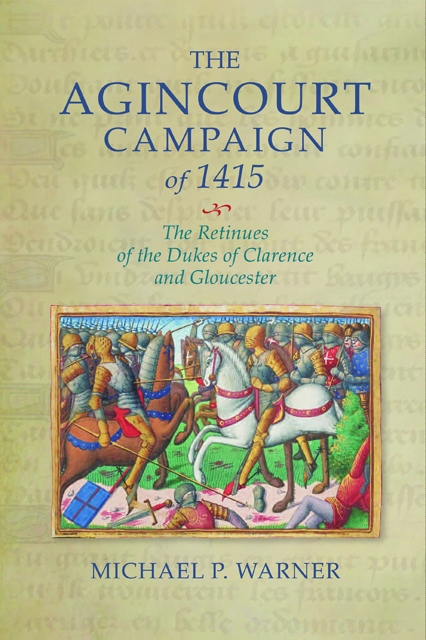Book contents
- Frontmatter
- Contents
- Lists of Tables and Charts
- List of Figures
- Acknowledgements
- Abbreviations
- Introduction
- 1 Before the Campaign
- 2 The Muster Rolls of the 1415 Expedition
- 3 Clarence’s and Gloucester’s 1415 Retinues
- 4 The Sub-Retinue Captains
- 5 During the Campaign
- 6 After the Campaign
- Conclusion
- Appendices
- Bibliography
- Index
- Warfare in History
3 - Clarence’s and Gloucester’s 1415 Retinues
Published online by Cambridge University Press: 14 January 2023
- Frontmatter
- Contents
- Lists of Tables and Charts
- List of Figures
- Acknowledgements
- Abbreviations
- Introduction
- 1 Before the Campaign
- 2 The Muster Rolls of the 1415 Expedition
- 3 Clarence’s and Gloucester’s 1415 Retinues
- 4 The Sub-Retinue Captains
- 5 During the Campaign
- 6 After the Campaign
- Conclusion
- Appendices
- Bibliography
- Index
- Warfare in History
Summary
At Southampton on 20 July 1415, less than three months after having sealed his indenture, Clarence’s retinue was mustered at St Catherine’s Hill, near Christchurch, in the New Forest. When taken as a whole, Clarence’s muster roll records the names of 243 men-at-arms and 789 archers. At face value, the roll details that Clarence went beyond his original indenture and, rather than raising a total of 960 men (240 men-at-arms and 720 archers), actually raised 1,032. However, as shown, to presume that every individual listed on the roll was actually present at the muster would be a mistake. As appendix two shows, it is unlikely all those listed on the muster roll departed for Normandy with the duke. In total, 47 archers are not pointed, along with one man-at-arms. Two archers have been crossed out completely, and one received a revocation of protection. Taking these annotations into consideration, and bearing in mind the various issues associated with the muster rolls as discussed previously, it may be concluded that when Clarence’s retinue departed for Normandy, it comprised 242 men-at-arms (one duke, one earl, two bannerets, 11 knights, 227 esquires) and 738 archers, a total of 980 soldiers.
In terms of overall size, Clarence evidently went marginally beyond the obligations of his original indenture for 960 men. The troop type composition of his final retinue, however, did not specifically fulfil his contractual obligations. He was meant to recruit 14 knights but appears only to have managed to recruit 11. It is possible that the additional archers he recruited were to make up for the shortfall in knights. Concerning letters of protection and attorney, which we shall return to shortly, only 27 of all the soldiers detailed on the muster roll sought such documents.
Before continuing further, it is necessary to focus briefly on the number of pointed names and additional annotations on the roll. On the whole roll, only one man-at-arms is not pointed. His first name is illegible, but his surname reads Joce. He was meant to serve under the command of the esquire Ralph Cromwell, the future Lord Cromwell. Clarence and his sub-captains must have been pleased to see almost all their men-at-arms appear, presumably properly equipped, at muster. The situation for the archers was rather different.
- Type
- Chapter
- Information
- The Agincourt Campaign of 1415The Retinues of the Dukes of Clarence and Gloucester, pp. 71 - 88Publisher: Boydell & BrewerPrint publication year: 2021



